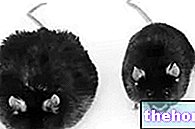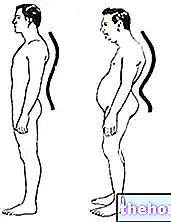Foods provide the energy needed to carry out the various biological processes that continually follow one another in our organism.

Triglycerides represent 65% of adipose tissue and about 90% of adipocyte mass (adipocytes are the typical cells of adipose tissue).
In man there are two types of adipose tissue, the white one (WAT from the English White Adipose Tissue) and the brown one (from the English Brune Adipose Tissue).
White adipose tissue
White adipose tissue is so called because under the microscope it looks like a yellowish-white mass, whose color is due to the presence of carotenoids. Between the two, WAT is the most common type of adipose tissue in the body and its main function is to produce and store energy.
White adipose tissue consists of unilocular cells containing a g

The WAT is present in the hypodermis, in the mesentery and in the mediastinum. Its functions, in addition to the aforementioned energetic role, are mechanical (support and protection) and thermal insulation (attenuates the dispersion of body heat). In the plasma membrane of the white adipocytes are present enzymes, called LIPOPROTEINLIPASES which are secreted into adjacent endothelial cells. At this level, they break down the bond between triglycerides and the proteins that transport them in the blood. In this way, triglycerides and free fatty acids can enter the "inside" adipocyte to be then used for energy purposes or stored as a reserve.
The WAT also has the ability to regulate appetite, the intensity of which is directly proportional to the number of adipocytes with reduced lipid content, especially through the production of leptin.
Brown adipose tissue
The second type of adipose tissue (BAT) shows a brownish color, due to the presence of numerous mitochondria. Compared to white adipose tissue, it is much less abundant in the body.
BAT is made up of multilocular cells, that is, containing numerous fat vesicles. In addition to being particularly rich in mitochondria, these cells have a cytoplasmic volume higher than white adipocytes.
In the mitochondrial crests of the inner membrane there are proteins called UPC-1 (also known as uncoupling proteins or thermogenins). These proteins are activated by the release of fatty acids and have the ability to dissipate the proton gradient at the level of the inner mitochondrial membrane. This gradient (fewer protons inside than outside) is critical for the synthesis of ATP. When this gradient is dissipated by the thermogenins, heat is produced instead of ATP, according to a phenomenon called ADAPTIVE THERMOGENESIS.
Ultimately, the UCP-1 is intended to produce heat when the body is exposed to low temperatures. Brown adipose tissue also has the ability to activate itself in case of excessive calorie intake from the diet. In theory, this phenomenon, based on the dispersion of the energy surplus in the form of heat, should guarantee the homeostasis of body weight, regardless of food excesses.
In overnourished rats, an increase in thermogenesis was shown, with a preventive effect on the development of obesity. Brown adipose tissue responded to this condition with the same metabolic and structural changes activated during cold thermogenesis.
In genetically obese rats, brown adipose tissue has a reduced thermogenetic capacity.
The reduced presence of brown adipocytes in an adult individual therefore seems to be one of the many pathogenetic mechanisms underlying obesity.
Functions of adipose tissue
Adipose tissue is not only responsible for the incorporation or release of fat available for energy activity, but behaves like a real organ, capable of secreting various proteins (leptin, GLUT4, TNF-alpha, PPARgamma, UCPs) that influence the entire body metabolism. The attention of researchers engaged in the fight against obesity is focusing on the function of these biochemical mediators and their therapeutic potential.




























